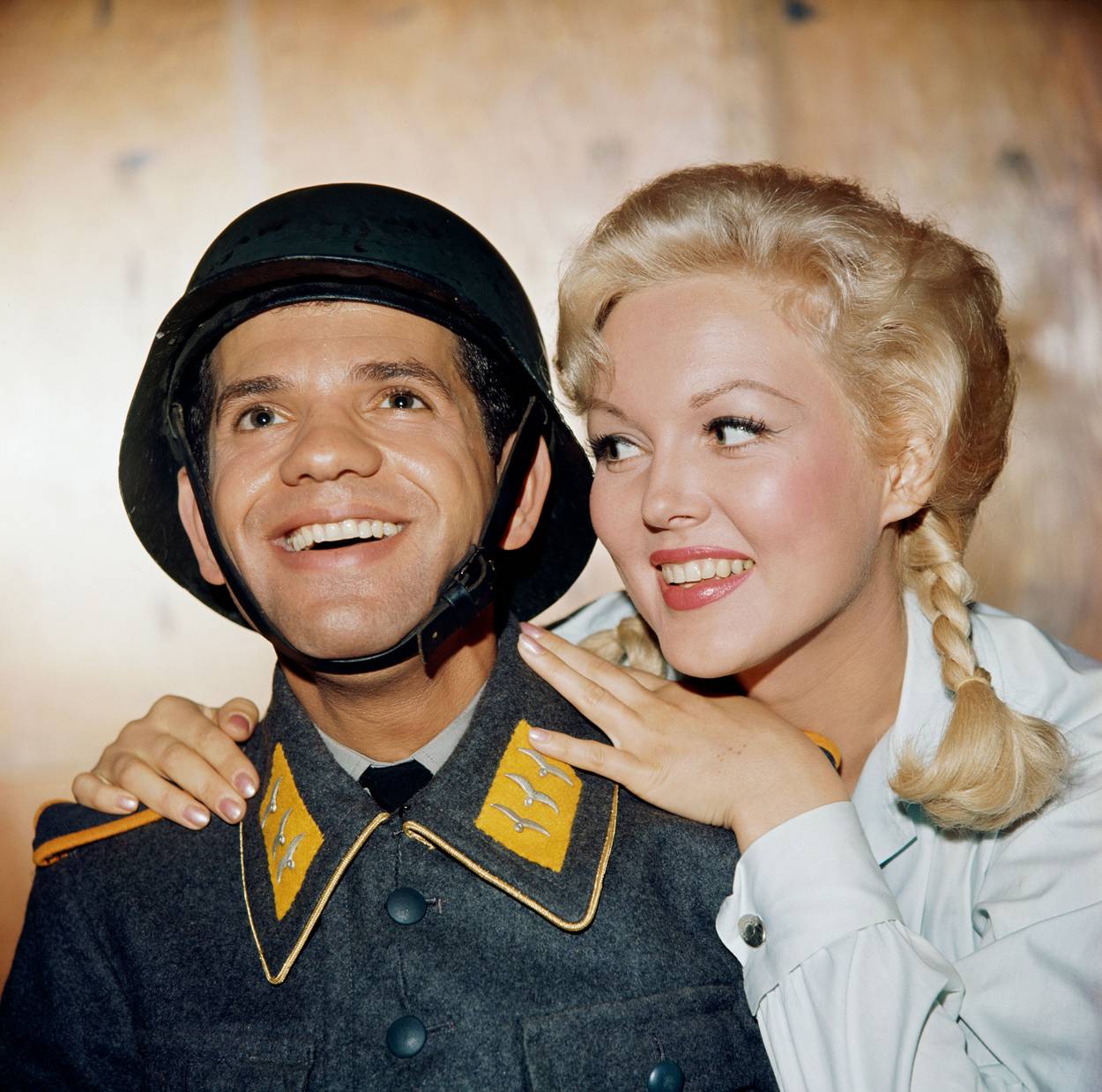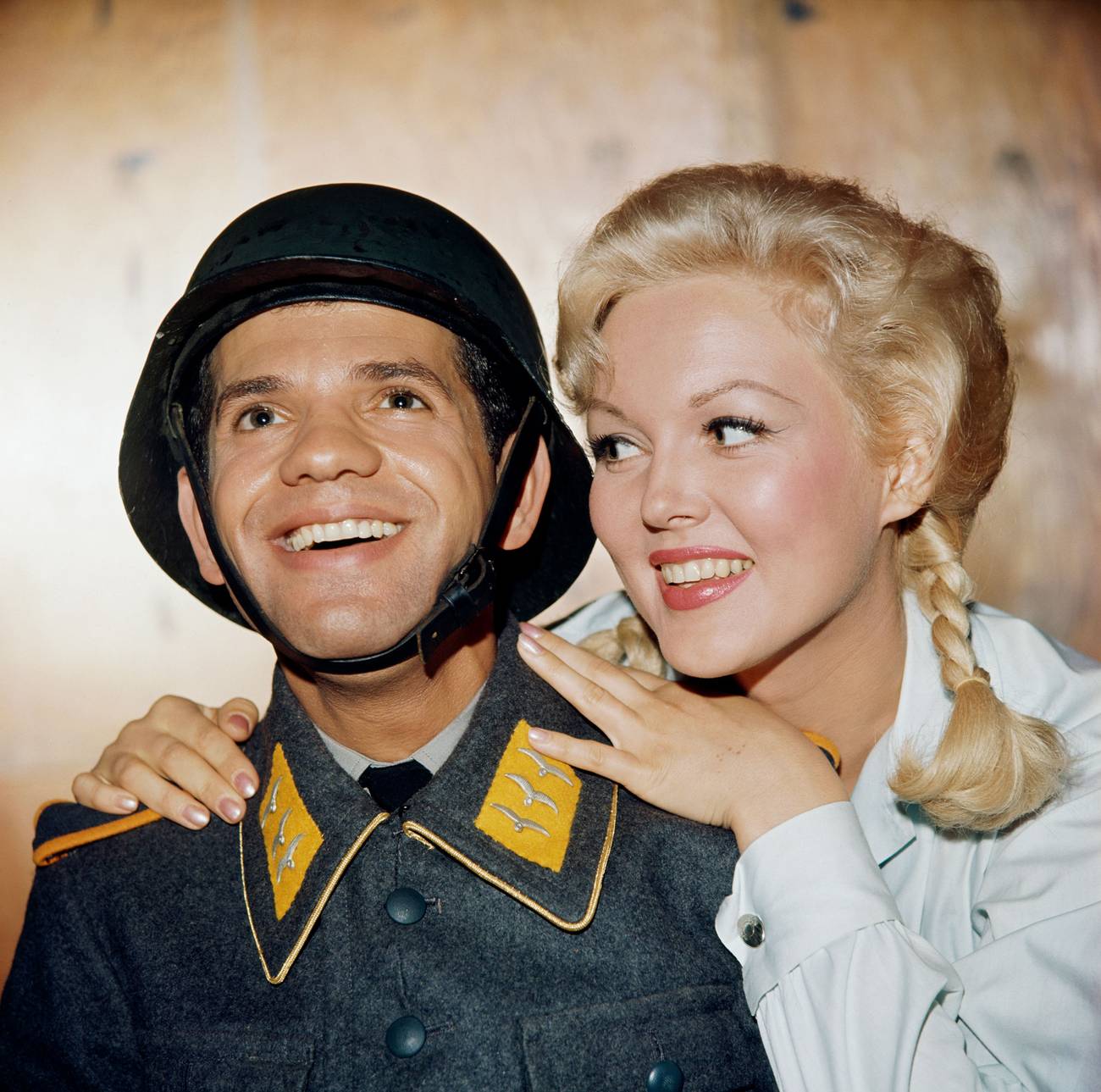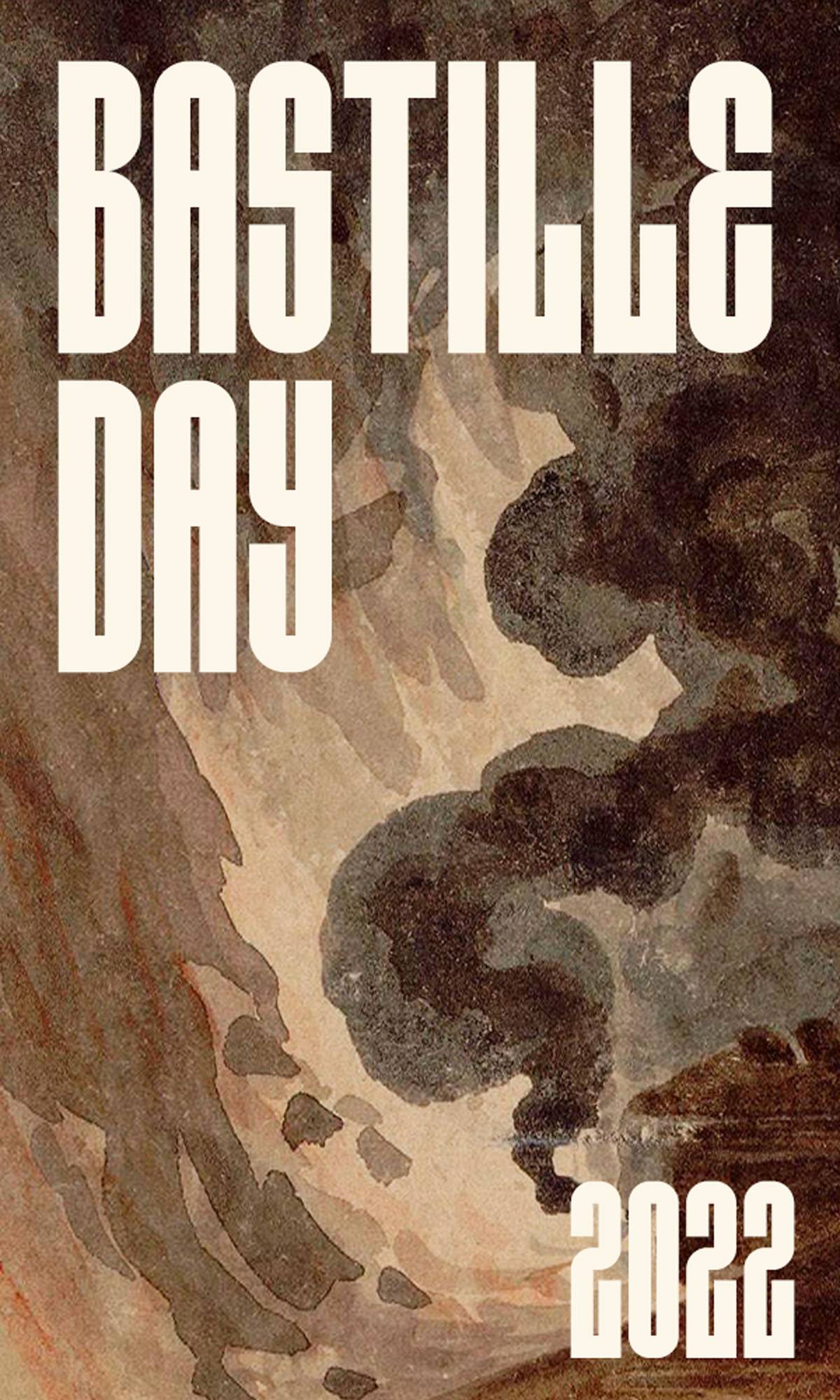They Loved Me in Buchenwald
A tribute to Robert Clary, the French American actor who survived the Holocaust to take Hollywood by storm




A week after Patton’s Third Army liberated Buchenwald, on April 19, 1945, the inmates gave a concert for the soldiers who had freed them. Fourteen Czech, German, Dutch, Belgian, and French musicians made up the band. The Simon Wiesenthal Center in Los Angeles has the fading typed program on exhibit: There were sax, brass, and rhythm sections, and a sole vocalist—a Frenchman, Robert Widerman, who sang “In the Mood,” “A Tisket, A Tasket,” and “Honeysuckle Rose.” He also performed both roles in a Mickey and Minnie Mouse skit of his own creation, which had been a hit with the Nazis and kapos.
“We performed on the stage, in our striped uniforms, exhilarated by our new freedom, and gave the greatest show of our lives which hundreds of GIs and inmates applauded and shouted,” he noted in his memoirs. They closed the set with a “walloping version of ‘Tiger Rag.’”
A few weeks later, back home in Paris, the boyish but indefatigable Widerman, age 19, opened at the legendary Olympia on the Boulevard des Capucines, then one of the many Parisian venues requisitioned for American soldiers’ entertainment. He was the fourth on the bill, in an unenviable slot right after a performing dog act that always thrilled audiences. His first number was “Flat Foot Floogie,” followed by “Daisy Venez Avec Moi.” The audience wasn’t buying it. He was distraught at the perfunctory applause. “I had two more numbers to do, and I was having flop-sweat. I didn’t understand—they loved me in Buchenwald!”
The singer, who had changed his surname to Clary, took gigs all over Paris, working full time, dancing with socialites and prostitutes (“I remember one in particular. She was tall and looked like Joan Crawford … a very good jitterbugger. We had a ball on the dance floor.”) He performed in blackface. He made friends with Charles Aznavour. He relocated to the south of France and worked around the clock.

Then, in 1947, American musicians went on strike. U.S.-based record producers scoured Europe for talent and one of the shrewdest A&R men, Harry Bluestone, visited France and immediately took to Clary, who was then touring on the Riviera. Thanks to Bluestone, lightning struck. Clary recorded a few songs which, a world away and unbeknownst to him, became hits in the U.S. His rendition of “Put Your Shoes on, Lucy” sold half a million copies and he charted on Billboard.
Offered a residence visa to move to the U.S., Clary did not hesitate, and manfully worked through the tearful adieus in France to a stay in New York and then Los Angeles. Meanwhile, his beloved sister Nicky, his family’s only other death camp survivor, had married a Texan and began what would be a long and happy life in suburban Dallas. (Clary would later visit there and serenade this sister and an overflow audience of Pepsi executives, including Richard Nixon, their lawyer, and Joan Crawford, wife of the CEO, on the eve of President Kennedy’s assassination, and continue to perform at the venue into mid-November, to predictably paltry audiences.)
The Kennedy assassination shocked but did not devastate a man who had spent years falling asleep next to death camp berth mates who would become corpses by the morning. But he had made a firm decision to veil his tragic youth in the past. Instead he faced the future, aspiring to music and comedy. His albums, a mix of ebullient French- and English-language standards, sold well.
“Robert Clary began singing as long ago as he can remember,” read the prim liner notes of the 1955 album Meet Robert Clary. “Just as he was hoping to begin on a singing career, he was uprooted by the war and sent to a prison camp for the duration. With the coming of peace, he made the rounds of French radio stations and cafes … [which] led to an engagement at Olympia Hall in Paris, and his career had begun.”
In LA, Clary rented a small apartment on Orchid Avenue behind Grauman’s Chinese Theater on Hollywood Boulevard. Clary made the rounds of agents and producers, appeared on talk shows, and occasionally splurged on dinner at the Pig n’ Whistle or Musso & Frank’s. Used to French meals consisting of several small courses, he was puzzled by the way Americans served a huge platter of “too much food” all at once. He felt fortunate that he had no French friends, as he was forced to focus on improving his English.
“I always loved ‘À Paris’ by Yves Montand,” Clary himself notes in his own contribution to the Meet Robert Clary liner notes. In fact, he and Montand burst onto the heady American scene at about the same time. While Clary hit Broadway in the musical revue New Faces of 1952 with, among others, Eartha Kitt, Alice Ghostley, and Paul Lynde (he crushed on both women but would recall Lynde as “cruel” and “antisemitic” especially when drunk), Montand starred in his own musical show. Both entertainers were thrilled by exuberant postwar America. The spell the New World cast extended even to the lefty Simone de Beauvoir, who marveled in her travel memoir America Day by Day that Los Angeles was “the size of the whole Cote d’Azur” and that LA martinis were “to martinis in Paris what the ideal circle is to the circles drawn on a blackboard.”
On visits to New York and Montreal, Clary maintained his friendship with Aznavour, but French Hollywood at the time consisted largely of the chic wives of actors and was difficult for him to break in. Meanwhile, Montand and his wife, Simone Signoret, made their social debut in LA, as Signoret wrote in her autobiography, thanks to “the three French ladies of Hollywood”—Anne Douglas, Quique Jourdan, and Véronique Peck. Kirk and Anne Douglas gave the Montands an introductory party to meet Judy Garland, George Cukor, Dean Martin, and Walt Disney (Montand bugged Disney about unanswered fan mail he’d sent him at age 13). At the time, Clary was still learning English and playing joints but would soon eclipse nearly all of them in popularity.
Clary befriended nascent Hollywood insider Merv Griffin, who introduced him to Eddie Cantor’s daughter Natalie, whom he would eventually marry after more than a decade of being best friends. Griffin loved to joke about Clary’s first experience, at Griffin’s mother’s house, with corn on the cob, of which he knew nothing except that French farmers fed it to their animals. He adored the taste, though, and—in Griffin’s probably apocryphal telling—handed the bare cob back to his hostess for her to rekernel for a second helping.
In an innocent American age when it seemed everything French was sexy, cute, and chic—Bardot, Warner Bros.’ romantic skunk, Bob Hope’s ooh-la-la jokes about the Place Pigalle, the crêpes suzettes in fancy French restaurants American couples aspired to in every 1960s sitcom, from I Love Lucy to Pete and Gladys—Robert Clary stood out as French par excellence. He starred in New Faces of 1952, the musical revue turned film release by Twentieth-Century Fox, the first musical shot in Cinemascope. It was a hit, and Clary’s first real break, leading to his next and definitive big break.
Clary initially resisted the French stereotype, at first refusing to sing the crowd-pleasing song “Lucky Pierre” in New Faces, though he would eventually go along with it and succeed beyond his wildest dreams. In his latter acting years, in the 1980s, on The Young and the Restless, Clary rejected the producer Bill Bell’s suggestion that his nebbishy character be called “Frenchy.” “That’s a no-no. Please do not call me Frenchy,” Clary pleaded. He’d had enough of cliches. Funnily enough, they settled on the character being named “Pierre.” He wrote in his autobiography that “I have a huge stamp on my name. it says in big letters ‘TINY FRENCHMAN.’”
Then came the pilot for the sitcom Hogan’s Heroes, set in a Nazi POW camp, and his career-defining character as a tiny Frenchman, Louis LeBeau, who was not only a valiant little prisoner of war but also a gourmet chef (naturally). Some episodes featured him wearing a French chef’s white toque instead of his usual béret Basque. Successive seasons gave Clary more to do as his character developed, and his memoir, titled, like it or not, From the Holocaust to Hogan’s Heroes—dwells on issues he had to contend with, with growing impatience, over the decades: No, he did not mind playing a prisoner of the Germans. The Germans in the sitcom were Luftwaffe and not necessarily Nazis, and a stalag observed the Geneva Convention and was not a concentration camp. The actors who played Colonel Klink and Sergeant Schultz—German Werner Klemperer, son of conductor Otto Klemperer, and Austrian John Banner—were Jews and he adored them as his “best friends” during the making of the show and as they aged together companionably in Los Angeles. Ivan Dixon, who played Kinchloe, was a brilliant performer who had already made the intense black-and-white movie Nothing but a Man in 1964; he would be the only cast member to quit the series for more ambitious work acting and directing. The only hint of tensions was with Bob Crane, who was the sole Republican.
Hogan’s Heroes, Clary notes, would remain a global hit for decades to come, even in Germany, under the name A Cage Full of Heroes.
Clary’s third act, after the daytime dramas, was a quiet one. His reticence about the Holocaust ebbed in the 1980s, when he was horrified by the soft and overt antisemitism of Patrick Buchanan and David Duke in the television news in the 1980s, and he started to speak out about his experiences. This was “the best thing I did in my life” he told the Hollywood Reporter in 2015. His nightmares about the Holocaust, common since the 1940s, finally stopped.
There had been a time when it was common enough for World War II refugees to run into each other at parties, in major European and American cities, including Los Angeles, and in Clary’s telling, these encounters had always been low key. Where were you in the war? Prisoner? Me too. Where? Ah, you were in a camp, which one? Buchenwald. Ravensbruck, Treblinka ... How long? Right. And the subject was dropped in favor of current events, gossip, or sports.
But a much fuller catharsis came when Clary attended the World Gathering of Jewish Survivors of the Holocaust in Jerusalem in 1981. He instinctively took to Israel, Jerusalem, and the survivor community, connecting with the now aged, paunchy Israelis he had known as skinny young Parisians. He visited Yad Vashem and gave an interview for a documentary, where, for the first time, he broke down weeping uncontrollably. He could not stop, or explain to the interviewer, Dr. William Rader, why he was crying, except finally to speculate, a few minutes later, “Maybe I should have died.”

Clary’s Polish, Orthodox Jewish father, Moishe Widerman, had emigrated to France but never really learned French despite his marriage to a Frenchwoman. Moishe was a distant parent, but his mother, Baila, doted on her children. Robert’s idyllic childhood in the large family ended with detention at Drancy, and being trucked through Germany, where the truck bed of terrified children drove past young Germans to laughter and taunts of “Dirty Jews!” On arrival at the camp, he narrowly missed instant selection and murder due to his apparent youth (“I was 16. I looked 12”). His mother’s last word to Robert in the death camp, before they were separated, was “Behave.” She knew that one wrong word from her quirky, loudmouth son could condemn him to the gas. Both parents were murdered within a week of arrival, which cost Clary his religious faith for good.
In Jerusalem, Clary’s sadness deepened, not only because of the memories being unearthed, but due to the logistics of the conference itself:
“My depression was a culmination of everything—being bused to Tel Aviv, being in this big place, and feeling that I was back in the camp taking orders (go to door G, not H; stay in line; wait your turn; stand up; sit down; salute; sing; stop; applaud; cry). All these things got to be too much for me.”
Far from dissuading Clary from probing his painful memories, the experience confirmed his educational mission and once back in California he quickly resumed his speaking activities, particularly at high schools, on behalf of the Simon Wiesenthal Center. He also resumed his hobby of painting.
Two years ago, I reached out via Tablet contributor Noah Pollak and Rabbi Abraham Cooper to ask to interview Clary, who is now 96 and lives in Beverly Hills. The answer was an extremely polite no, saying he was not giving any more interviews. His final public conversation was with the Television Academy Foundation (he stated in that interview that it would be his last: “No more talking, no more yak-yak-yak! I’ll whistle, and dance, but no more talk.”)
“Everything I did,” he responded to a question about his proudest achievement. “To have people liking me. It’s rewarding. I loved the theater.” When his interviewer began to tee up “a last question we like to ask” he recoiled at the word “last” and mugged clownish sobbing at the prospect of the conversation ending. “What! Last?!” His comically drooping mouth and Looney Tunes whining would have done Mel Blanc credit. At the actual question, though—“How would you like to be remembered?”—he turned serious.
“I don’t care. I really mean that. I really don’t care. They will remember me as a nice person? Fine. Remember me as a dirty Jew? Fine. I don’t care because I won’t be here. I’m not going to worry about it. … When I’m dead, I’m dead, who cares? I’ll never know. Nobody’s gonna tell me, not even God. Is God going to tell me, ‘You know what they’re talking about you?!”
Peter Theroux is a translator and writer in suburban Los Angeles. After more than 20 years in the U.S. government, he was awarded the Career Intelligence Medal.